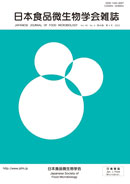
- Issue 4 Pages 103-
- Issue 3 Pages 81-
- Issue 2 Pages 57-
- Issue 1 Pages 1-
- |<
- <
- 1
- >
- >|
-
Takahisa Miyamoto2023Volume 40Issue 4 Pages 103-112
Published: December 30, 2023
Released on J-STAGE: January 12, 2024
JOURNAL FREE ACCESSDownload PDF (1372K)
-
Takuya Mizuno, Makiko Noda, Noriko Koike, Kumiko Kirii, Tomohiro Yamag ...2023Volume 40Issue 4 Pages 113-121
Published: December 30, 2023
Released on J-STAGE: January 12, 2024
JOURNAL FREE ACCESSThis study aimed to determine the cause of growth inhibition of diarrheagenic Escherichia coli (DEC) in modified EC (mEC) broth containing other bacteria. The growth of DEC in mEC broth with non-DEC bacteria was evaluated by lactose fermentation, growth rate, and the ratio of DEC to non-DEC bacteria before enrichment culturing. The results showed that non-lactose fermenting bacteria did not compete with DEC because lactose contributes considerably to the growth of bacteria in mEC broth. In the mEC broth, all the bacteria stopped growing after the total number of bacteria reached approximately 9.0 log CFU/mL, primarily because of lactose depletion. Moreover, the growth of DEC in mEC broth with coliform bacteria depends on the ratio of DEC to coliform bacteria in the specimen and the growth rate of coliform bacteria. However, DEC isolation cannot exclude the influence of non-pathogenic E. coli in the specimen because most DEC possess drug susceptibility and biochemical characteristics similar to non-pathogenic E. coli. Estimation of the DEC population in mEC broth after enrichment culturing by quantitative PCR is useful to predict the result of DEC isolation. Moreover, the use of isolation media other than those identified by lactose fermentation can improve the detection rate of DEC.
View full abstractDownload PDF (619K) -
Nozomi Sakakida, Saeko Takase, Yuka Yamazaki, Satomi Kando, Kaori Kash ...2023Volume 40Issue 4 Pages 122-128
Published: December 30, 2023
Released on J-STAGE: January 12, 2024
JOURNAL FREE ACCESSThe definition of EASTEC refers to Escherichia coli strains lacking any well-established diarrheagenic factors except for the enteroaggregative E. coli (EAggEC) heat-stable toxin 1 gene (astA). However, the causative food source has often remained unidentified in these outbreaks, possibly due to the lack of appropriate detection methods for EASTEC in food products. To address this issue, we conducted a study comparing different strains of EASTEC O166:H15, the most common serotype, with varying origins, and investigated the usefulness of various culture and screening methods, including real-time PCR. We found that the growth of all tested strains was suppressed on agar containing cefixime-tellurite supplement or 2 mg/L tobramycin, but not on agar with 1 mg/L tobramycin. In the additive recovery test, CHROMagar STEC with 1 mg/L tobramycin and SMAC with 1 mg/L tobramycin showed relatively high detection rates. Furthermore, real-time PCR of the inoculum showed a detection sensitivity of 1.00 (20/20) under all enrichment culture conditions, with Ct values around 20. Based on our results, we conclude that a combination of the culture method using tobramycin-added selective agars and screening by real-time PCR may be an efficient and effective method for detecting EASTEC in food products.
View full abstractDownload PDF (407K)
- |<
- <
- 1
- >
- >|